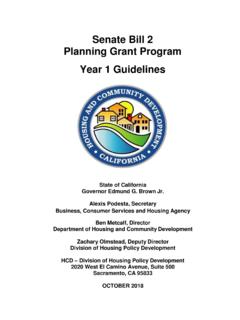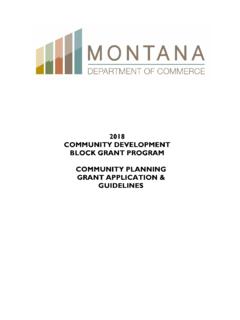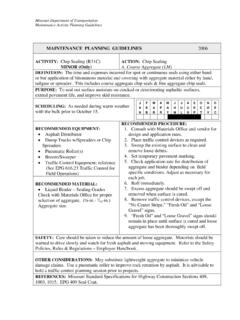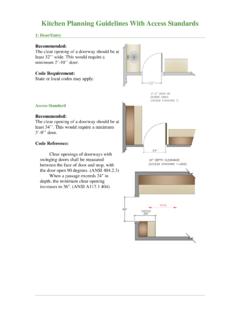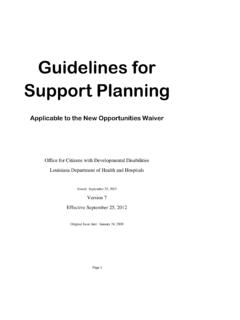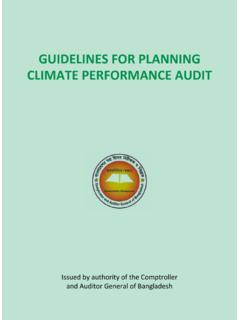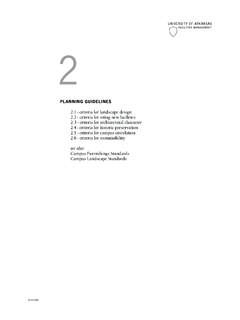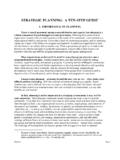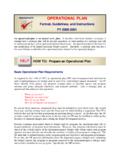Transcription of FACILITATOR GUIDELINES FOR CONDUCTING A PLANNING …
1 FACILITATOR GUIDELINES FOR CONDUCTING A PLANNING WORKSHOPCARING FOR NEWBORNS AND CHILDREN IN THE COMMUNITYFACILITATOR GUIDELINES FOR CONDUCTING A PLANNING WORKSHOPWHO Library Cataloguing-in-Publication Data:Caring for newborns and children in the community: FACILITATOR GUIDELINES for CONDUCTING a PLANNING Welfare. Welfare. Health Services. , Newborn. Health Services. Materials Health Organization. 978 92 4 150858 2 (NLM classification: WA 320) World Health Organization 2015 All rights reserved. Publications of the World Health Organization are available on the WHO website ( ) or can be purchased from WHO Press, World Health Organization, 20 Avenue Appia, 1211 Geneva 27, Switzerland (tel.: +41 22 791 3264; fax: +41 22 791 4857; e-mail: for permission to reproduce or translate WHO publications whether for sale or for non-commercial distribution should be addressed to WHO Press through the WHO website ( ).)
2 The designations employed and the presentation of the material in this publication do not imply the expression of any opinion whatsoever on the part of the World Health Organization concerning the legal status of any country, territory, city or area or of its authorities, or concerning the delimitation of its frontiers or boundaries. Dotted and dashed lines on maps represent approximate border lines for which there may not yet be full mention of specific companies or of certain manufacturers products does not imply that they are endorsed or recommended by the World Health Organization in preference to others of a similar nature that are not mentioned. Errors and omissions excepted, the names of proprietary products are distinguished by initial capital reasonable precautions have been taken by the World Health Organization to verify the information contained in this publication.
3 However, the published material is being distributed without warranty of any kind, either expressed or implied. The responsibility for the interpretation and use of the material lies with the reader. In no event shall the World Health Organization be liable for damages arising from its in SwitzerlandFACILITATOR GUIDELINES FOR CONDUCTING A PLANNING WORKSHOPCARING FOR NEWBORNS AND CHILDREN IN THE COMMUNITYFACILITATOR GUIDELINES FOR CONDUCTING A PLANNING WORKSHOPCONTENTSI. Preparations ..1II. Example Workshop Schedule ..6 III. FACILITATOR briefing and training ..10IV. GUIDELINES for CONDUCTING the workshop ..15 DAY 1 ..15 DAY 2 ..30 DAY 3 ..33 DAY 4 .. I. PREPARATIONSM aking the preparations described below will enable a successful workshop to plan implementation of selected packages in Caring for Newborns and Children in the CommunityffPURPOSE OF WORKSHOP: To bring relevant people together and provide a method and structure to make a good start on PLANNING for implementation of community-based packages, as described in the PLANNING Handbook ffTARGET AUDIENCE:Planners and managers of community-based services for pregnant women, newborns and children from the Ministry of Health (national, regional and district levels) and from partner organizations (WHO, UNICEF, NGOs) involved in support and implementation of community-based servicesffDESIRED OUTPUTS.
4 Selection of the community-based packages from Caring for Newborns and Children in the Community to be implemented or expanded in the countryDraft plan for implementing the selected packages which specifies key steps and actions for each component ffWORKSHOP OBJECTIVES: To increase the participants knowledge about the three community-based packages in Caring for Newborns and Children in the Community, their benefits and requirements To guide participants to select the best mix of interventions and packages to expand or add in their country To guide the participants to draft a plan for implementing the selected packages in the context of current country activitiesffPRELIMINARY PLANNING MEETING:Convene a PLANNING meeting well ahead of the potential workshop (such as 3 months prior) with high-level ministry staff to decide whether to conduct the workshop, and to make necessary decisions to begin preparations.
5 At that meeting:1) Review the PLANNING process in the Handbook: The Director of Community Health and other decision makers should get an overview of the PLANNING process described in the Handbook and the workshop objectives. This understanding is important so that he or she can decide whether the workshop will be helpful and then make subsequent plans and decisions. It is also important that the leadership commits to CONDUCTING the workshop and then supporting further development and implementation of the plans coming out of the workshop. 2) Agree on the date and location for the workshop3) Select participants and facilitators: 4 working groups are needed of 6 to 10 participants each. (See Target Audience on the previous page.) Participants should include district health leadership, personnel from MOH, UNICEF, WHO, and NGOs, among others.
6 Strong participation from districts is crucial. Participants should be knowledgeable on one or more of the following: human resources for health; training; supply chain logistics; service delivery at district, health facility and community levels; advocacy, community mobilization and participation, health promotion; supervision; monitoring and evaluation; costing and financing. At least some of the facilitators should be familiar with the workshop because they have conducted it or participated in it before; individuals may be offered by partner agencies (such as WHO, UNICEF, Save the Children). All facilitators must be willing to participate in a full 1-day FACILITATOR briefing prior to the GUIDELINES for CONDUCTING a PLANNING Workshop4) Identify any key issues/weaknesses that will need to be addressed in PLANNING : Awareness of key weaknesses is important so that they will be mentioned in presentations and so that participants can be invited who have the knowledge to contribute to plans for solutions.
7 (For example, if supply chain is a known weakness, plan to include national, sub-national, and district level supply chain managers, MOH pharmacist, etc.). 5) Identify documents needed: List the relevant policy documents (for example, on IMNCI, community case management, ANC, PHC, CHWs), plans ( RMNCH Road Map), implementation reports, indicator data, and reports on any community health-related mapping exercises. These documents will be gathered and used to prepare for the workshop (as described in Preparations, below). Some will be made available for reference during the workshop. 6) Identify sources of funding for the workshop7) Appoint a team to complete PLANNING and organization of the workshop: They will complete the items listed in Preparations, : Invite participants: Participants should expect to attend the entire 4-day workshop ( 9:00 to 18:00 each day) and to work hard, actively contributing to discussions and PLANNING .
8 They should bring information to the workshop about health and health system functioning at community level. (A list of information should be provided with the invitation.) Confirm/invite facilitators: 1 or preferably 2 per subgroup; 1 or 2 lead facilitators to manage the flow of the workshop and conduct the plenary sessions. The facilitators should be experienced leading small groups through specific tasks and should be familiar with the three WHO-UNICEF recommended community-based packages. Encourage the invited facilitators to read/study the three packages so that they will be insightful about the necessary work to implement them in the country. Schedule a full day before the workshop for the FACILITATOR briefing. Facilitators will need to become completely familiar with the PLANNING Handbook, FACILITATOR GUIDELINES and agree on procedures, activities and roles in the workshop.
9 Arrange for venue and equipment: Plenary room with seating for all participants and facilitators, and a projector 4 subgroup rooms with table and chairs computer, preferably with projector and speakers, or other capability to show training videos (such as television with DVD player) thumb drive with workshop files for each subgroupMake arrangements for lunches and tea breaks. Ensure that lunch will be available on schedule and will not take longer than one hour. Arrange for any official opening/closing session: These events should be brief (no more than 30 minutes). They are important to lend weight to the importance of the workshop and its results, and to encourage the participants to commit to the full workshop. Arrange for secretarial support to manage administrative issues during the workshop.
10 On the first day the secretariat should prepare a list of all participants and facilitators with identifying information, including job title and location, and mailing and email address. This list should be proofed by all participants. The secretariat should then prepare the final version and distribute copies to all. Arrange to print or obtain materials for the participants and facilitators. This will include a copy of the PLANNING Handbook for everyone, as well as some materials from the three training packages: PLANNING Handbook FACILITATOR GUIDELINES for CONDUCTING a PLANNING Workshop Counselling Cards from Caring for the Newborn in the Community Family Counselling Cards from Caring for the Child s Healthy Growth and Development2I. Preparations Chart Booklet from Caring for the Sick Child in the Community1 Sick Child Recording Form For the facilitators of each small group: Video disks/files to show in small group NFrom Caring for the Newborn at Home: Clip 2: Early initiation of breastfeeding NFrom Caring for the Child s Healthy Growth and Development: Activity 12 Copy your child Files on a thumb drive: NSituation Description table, with themes and questions about the component NStatus of PLANNING Steps, table with steps from chapter in left column NPlanning Template Develop the schedule: Prepare a schedule of activities of the workshop and make copies to distribute to all participants.










